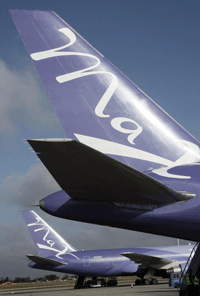Eos, L'Avion and Silverjet are confident of the all-business class model despite the demise of Maxjet
The transatlantic all-premium market will likely grow despite the failure of US-based all-business class carrier Maxjet.
The three remaining all-premium transatlantic carriers - Eos, L'Avion and Silverjet - plan to expand and following Maxjet's demise late in 2007 issued confident statements suggesting their niche remains at worse a concept that is still in the testing phase and at best an idea that is just about to catch on. The new model, with variations, rests on the premise that flying with an all-premium carrier is more calming and overcomes the advantages of network carriers, such as loyalty plans and global corporate accounts.
The model faces the biggest challenge when incumbent carriers react. American last October launched flights in Maxjet's key market, New York JFK-London Stansted, perhaps accelerating Maxjet's demise. Analysts say Maxjet, which had a slightly downmarket business class approach compared with Eos and Silverjet, was most vulnerable to American's onslaught and forced it to resort to fare slashing.
 Meanwhile, Maxjet's experiments in other markets from Stansted, including Washington, Las Vegas and Los Angeles, failed to flourish. Its choice of older Boeing 767s also left it open to mechanical problems.
Meanwhile, Maxjet's experiments in other markets from Stansted, including Washington, Las Vegas and Los Angeles, failed to flourish. Its choice of older Boeing 767s also left it open to mechanical problems.
New York-based Eos, with 44 weekly flights between JFK and Stansted, remains committed to the market and chief executive Jack Williams says it enjoyed a 64% traffic increase in October and November despite the start of American's Stansted service. Eos' choice of 757s configured with 48 lie-flat business class seats differentiated it from Maxjet, which configured its 767s with 102 traditional business class seats. "We are confident our business model works," says Williams.
Airport choice is at the heart of UK-based Silverjet's strategy, and it believes its base at London Luton, where it has its own terminal, is relatively immune to network carrier challenges. Silverjet chief executive Lawrence Hunt says Silverjet's "average yield was 50% higher than Maxjet's".
Silverjet operates to Newark and Dubai from Luton. It was able to raise another £22 million ($44 million) in December and is filling about 53% of its 100 seats on each flight. That's within 10 percentage points of breakeven.
The third survivor, Paris-based L'Avion, boasted a 79% load factor for December and in January added a second 90-seat 757 on its route between Paris Orly airport and Newark. It has yet to draw retaliation on the Paris route, although British Airways' new carrier OpenSkies plans to serve Paris and Brussels from New York.
OpenSkies, however, is not a direct challenge to the all-premium start-ups. Its 757s will offer three classes, with 24 business class beds, 28 premium economy seats, and 30 economy seats.
Meanwhile, Virgin Atlantic has put on ice plans to launch its own all-premium transatlantic operation. Scottish carrier City Star, however, plans to enter the market by year-end with an all business class 757 operating between Aberdeen and Houston.
Source: Airline Business
















